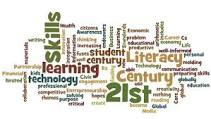
Too often we talk about 21st century schools, 21st century education, 21st century skills or 21st century learning – all of which are the same. But, what exactly does that mean? How is it different from the 20th century way of educating students?
21st century skills usually refer to certain core competencies that include collaboration, digital literacy, critical thinking, and problem solving. Schools need to meet these competencies. This is what is expected of students so they develop academically and are able to succeed in the information age. Literacy skills such as information, media, and technology are included as well as life’s skills of flexibility, initiative, social, productivity, and leadership.
All these have been important for many years but in today’s information-based society, they are expected to be in the forefront of learning. To prepare for the workforce, students must follow directions, get along with others, and produce their best work.
The global market demands critical thinking skills (questioning, predicting, investigating, hypothesizing, analyzing, reflecting, comparing, revising, evaluating, and forming opinions based on evidence). Most importantly it involves metacognition – reflecting on one’s own thoughts and knowledge.
The teacher’s role must be redefined. They need to move from being the knowledge giver (sage on stage) to the choreographer of the learning. They become the facilitator, guide and mentor that provide and direct sources and resources that enable learning. Cultures of inquiry and project based learning need created through the collaboration of teachers and students.
School leaders are under pressure to ensure that all students receive a high-quality education. This pressure includes staying in school, graduating on time and being college-ready. With decreasing budgets, an increase in English Language Learners, and a mobile society, they are faced with demanding challenges. They also face additional demand of educating women and girls in order to promote gender equality. Increasing girls’ education correlates with economic growth increased agricultural yields and greater labor productivity. Creating educated women ensures that babies are vaccinated and receive proper nutrition.
Schools of 20th century focused on what teachers taught. Covering the material was the main purpose, not the mastery of concepts. Schools of the 21st century focus on student learning and outcomes. What the teachers teach is second to what the students learn. Students must show continuous improvement and academic success. What students know and what they can do determines success.
Schools using the same methods and strategies from 15 to 20 years ago need to update their professional methodology and receive continuous professional development. If schools use the same methods as in the past, only some students will succeed and many will not. In today’s society, that is not acceptable. Schools need principals that are more than managers. Principals need to be instructional leaders. They need a community that supports student success with superintendents, principals, and counselors interacting together.
It is a daunting task to change from 20th century thinking and transform to the 21st century of a student-focused, differentiated model where all students must succeed. Today’s schools demand that the entire community work in unity to educate the whole child and ensure the success of all students for a better tomorrow.


